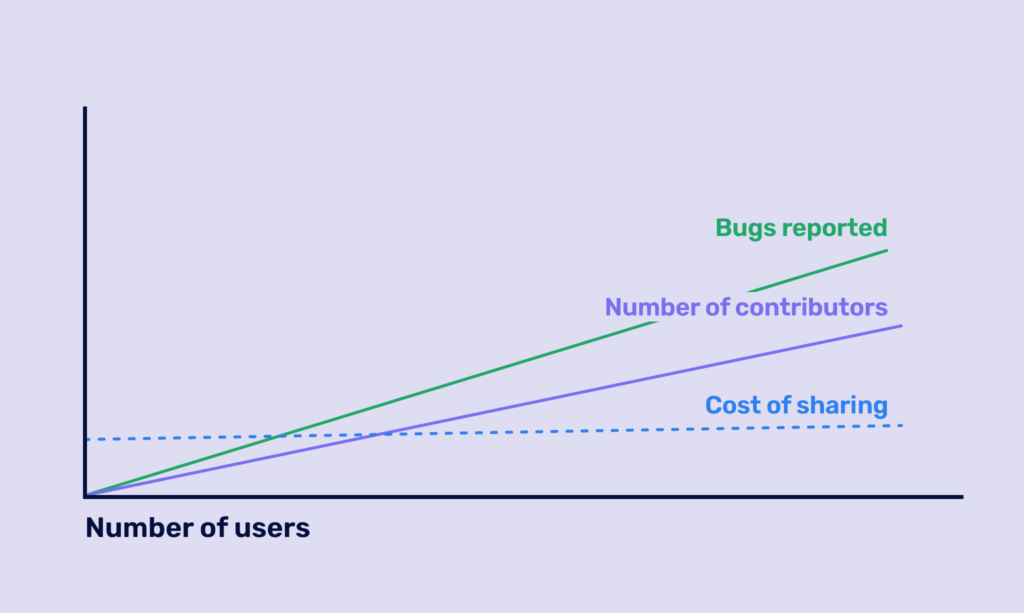1.3 A third category
Let’s talk about another type of good. Think about online video games, whether it something old school, like Runescape, or something more modern, like Fortnite. At first glance, these games may seem non-rival. They certainly are not rival, as anyone with access to a computer and internet connection can log on and play.
In fact, these games becom better the more people join them.
Goods that increase in value the more they are used are known as anti-rival goods.
Anti-rivalry
Anti-rival goods are characterized by their negative subtractability. The more people consume them, the more benefits emerge. Anti-rivalry is most helpful in understanding digital goods. Think about a mp3 file of a song – it is essentially costless to share, and sharing does not lower the value of the song. Instead, sharing the mp3 creates benefits for a larger number of people who can enjoy the music within the mp3 file.
The term anti-rival was introduced by Steven Weber in his 2004 book, The Success of Open Source. In it, he argues that free and open-source software is anti-rival. The more people use the software, the more valuable it becomes to others using it.
How is this possible?The more users there are in an open-source project, the more likely users are to report bugs or problem with the software. This allows designers and programmers to improve the product.
Additionally, an increase in users likely means an increase in contributors who can provide skills such as programming, marketing and project management.
At the same time, there is essentially no cost difference in sharing the software with one user, versus sharing it with 1000 users.

This means that many people can use the same software without decreasing its value, and in fact their use will provide information that can improve and increase the value of the software. Weber does note that this still requires a “sufficient number” of people who are actively contributing.
Anti-rival goods
While digital goods and data are the clearest example of anti-rival goods, they are not the only anti-rival goods. One of the most common examples used is language. The more people that speak a language, the more useful it is to learn! Below are three more examples of anti-rival goods.

Movie quotes
In a 2011 essay for TechDirt, Nina Paley argues that culture is anti-rivalrous. The more people engage with a culture, the more valuable it comes. Think, for example, of movies or literature. The more we quote or reference a movie, book, or play, the wider the understanding of that quote becomes. Read the quotes below:
- Say hello to my little friend!
- Frankly my dear, I don’t give a damn
- She turned me into a newt!
- I am your father.
You may not have even seen some of the movies these quotes come from, but chances are you recognize at least one of them. This recognition indicates a form of cultural value. The more they are used, the more value they hold
Climate change efforts
While not exactly a good, we can consider climate change efforts as anti-rival for the simple reason that they bring benefits to the whole world. The more who contribute, for example, to recycling, the greater the benefits, even to those who do not recycle.


Reggae
In a chapter of Copyright and Piracy, Jason Toynbee argues that reggae and its history mark it as an anti-rival good.
“Competing musicians and producers tend not to object to others using ‘their’ songs, sounds or riddims because they understand the result will be better music and a bigger market for everyone”
The more musicians who play reggae, borrowing beats and sounds, the more there is to enjoy, and the better the music gets.
Excludability of Anti-rival goods
Anti-rival goods can also be made excludable, for example by requiring registration to access a free game or website.
Below is an updated version of the matrix seen in the previous section. Here you can see how anti-rivalry fits in, and some more examples of anti-rival goods.

Anti-rivalry in action: Positive externalities
Anti-rivalry often becomes most visible in the form of positive externalities. Externalities refer to the impact of your choices on others. An externality can be positive (meaning it benefits others) or negative (meaning it causes harm or have a negative effect on others).
Let’s look at an example that can have both: A town decides to build a train station to increase accessibility and tourism. A positive externality is that pollution from cars is reduced and businesses near the train station see an increase in customers. A negative externality is increased noise pollution from the trains.
Externalities may seem minor at first, but they can add up to create a meaningful change. Many people driving many cars has contributed to climate change. Many people getting vaccines promotes their own health, but also reduces the risk of widescale infection.
Anti-rivalry (increased value with increased use) often appears as positive externalities. Let’s consider the above example of climate change efforts. If you decide to make an effort to reduce your carbon emissions (for example, by taking a train instead of driving a car), you are creating a positive externality for the rest of the world. The more climate-friendly decisions you and others make, the greater the positive externality (and the more valuable your choice is).
